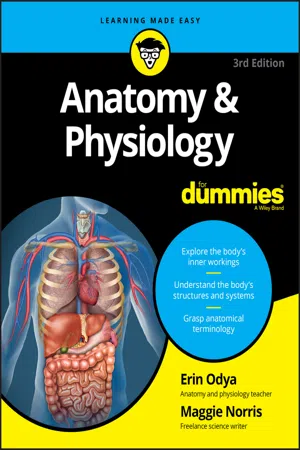
- English
- ePUB (mobile friendly)
- Available on iOS & Android
Anatomy & Physiology For Dummies
About this book
Learn about the human body from the inside out
Some people think that knowing about what goes on inside the human body can sap life of its mystery—which is too bad for them. Anybody who's ever taken a peak under the hood knows that the human body, and all its various structures and functions, is a realm of awe-inspiring complexity and countless wonders. The dizzying dance of molecule, cell, tissue, organ, muscle, sinew, and bone that we call life can be a thing of breathtaking beauty and humbling perfection.
Anatomy & Physiology For Dummies combines anatomical terminology and function so you'll learn not only names and terms but also gain an understanding of how the human body works. Whether you're a student, an aspiring medical, healthcare or fitness professional, or just someone who's curious about the human body and how it works, this book offers you a fun, easy way to get a handle on the basics of anatomy and physiology.
- Understand the meaning of terms in anatomy and physiology
- Get to know the body's anatomical structures—from head to toe
- Explore the body's systems and how they interact to keep us alive
- Gain insight into how the structures and systems function in sickness and health
Written in plain English and packed with beautiful illustrations, Anatomy & Physiology For Dummies is your guide to a fantastic voyage of the human body.
Frequently asked questions
- Essential is ideal for learners and professionals who enjoy exploring a wide range of subjects. Access the Essential Library with 800,000+ trusted titles and best-sellers across business, personal growth, and the humanities. Includes unlimited reading time and Standard Read Aloud voice.
- Complete: Perfect for advanced learners and researchers needing full, unrestricted access. Unlock 1.4M+ books across hundreds of subjects, including academic and specialized titles. The Complete Plan also includes advanced features like Premium Read Aloud and Research Assistant.
Please note we cannot support devices running on iOS 13 and Android 7 or earlier. Learn more about using the app.
Information
Locating Physiology on the Web of Knowledge
Anatomy and Physiology: The Big Picture




Scientifically Speaking
How anatomy and physiology fit into science
Table of contents
- Cover
- Title Page
- Table of Contents
- Introduction
- Part 1: Locating Physiology on the Web of Knowledge
- Part 2: Sizing Up the Structural Layers
- Part 3: Talking to Yourself
- Part 4: Exploring the Inner Workings of the Body
- Part 5: Life’s Rich Pageant: Reproduction and Development
- Part 6: The Part of Tens
- About the Authors
- Supplemental Images
- Connect with Dummies
- End User License Agreement
